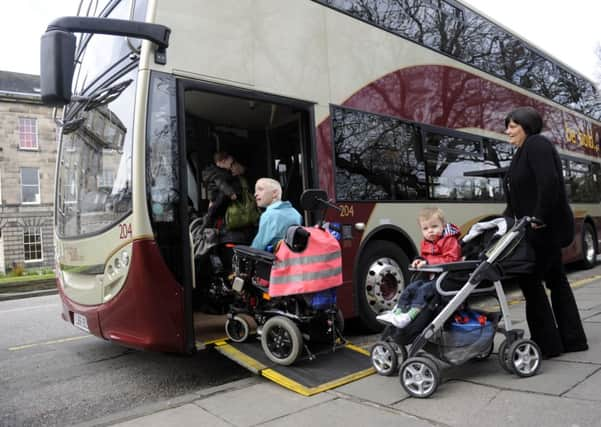Comment: Public transport for disabled to improve


FOR disabled Scots, access to public transport can be a postcode lottery. If you use a wheelchair in Pollokshields you will find your local taxi to be wheelchair accessible; but not necessarily if you live in Perth. In many rural areas, public transport is non-existent or scarce and for those without access to a car you may be lucky if a local community transport scheme provides some kind of access to local services.
There are improvements being made – Edinburgh’s new tram has state-of-the-art access and communications and easy-access, low floor buses are becoming the norm in many urban areas. All bus services must meet improved statutory standards by 2020. However, the depressing reality for many disabled Scots is that public transport is a “no go” area, with unsuitable vehicles, unpredictable standards of service and information provided in unusable formats. A recent study of the statutory equality outcomes of all Scottish councils found that fewer than half made any mention at all of transport accessibility.
Advertisement
Hide AdAdvertisement
Hide AdWith the strong relationship between age and disability and the National Records of Scotland forecasting a 28 per cent increase in the number of over 75s in Scotland by 2022, this problem is only going to grow. The need for more accessible transport is one recognised by the Chartered Institute of Logistics and Transport (CILT), which has been actively seeking more action across the industry.
To get everyone working together, a consultation on a proposed accessible transport strategy for Scotland has just been published by the Scottish Accessible Transport Alliance (SATA). It aims to get everyone involved – local and central government, transport operators, community and passenger groups – to sign up to a coherent plan to provide a decent level of access to transport for all disabled people in Scotland by 2020. Along with the strategy is an action plan, setting out 89 specific actions which are needed to achieve the goal of “access for all”.
These actions go further than dealing with the most obvious physical barriers which can impede or exclude disabled people such as high steps on buses or stairs in railway stations. They also address “soft” factors such as the provision of information in an accessible form, affordability, expectations of staff conduct, and support for disabled motorists. The strategy recognises that a joined-up approach is needed to make streets and public spaces accessible. A step-free bus is little use if the state of pavements prevents people from reaching the bus stop.
Crucially, the strategy recognises the diversity of mobility impairments. People who have difficulty walking, seeing, hearing or who experience high levels of anxiety all have different needs. For these needs to be met effectively, disabled people need a proper opportunity to explain their own requirements and to influence how services are designed and operated. The involvement of disabled people in service planning is seen as vital.
Putting such a plan into practice will be a challenge, not least on grounds of cost. Some measures – most obviously introducing more accessible vehicles, trains, and other infrastructure – will require significant investment. However, other measures, for example better planning, information and staff training, cost little or nothing.
New large-scale investment is being achieved by some transport authorities but there is more to do.
Transport for London announced on 1 October a project to make all stations on the Crossrail project step-free at a cost of more than £250m, which illustrates the scale of the ambition needed.
Co-ordination is a key issue in implementing any strategic plan, given the dispersed responsibilities for transport provision in Scotland (and the UK). No level of government – local, regional or national – controls all transport provision in their area, and of course passenger transport is overwhelmingly provided by private operators and providers.
Advertisement
Hide AdAdvertisement
Hide AdHow can these diverse bodies with their different interests and perspectives contribute to a single strategy for accessible transport? Integration of transport services has long been a strategic goal advocated by CILT, and in this essentially deregulated planning environment, probably the two key requirements are leadership, and a common strategic agenda. The SATA initiative has been strongly supported by CILT members since it may stimulate both.
Alan Rees, the principal author of the strategy and a founding member of SATA, said at the launch of the draft strategy that “Such strategies and action plans have been adopted in other parts of the UK. We in SATA want to see faster and more comprehensive progress towards better access to transport in Scotland”.
The initiative is not principally a call for spending; instead it aims to bring a wide variety of interests – from public, private and voluntary sectors – to sign up to a shared vision and programme of action. If that can be achieved, then bus companies, rail operators, government and other service providers will welcome the shared commitment as a first step towards a transport service that meets everyone’s needs in Scotland.
• David Hunter has been leading the Chartered Institute of Logistics and Transport’s work on access for disabled people in Scotland. www.ciltuk.org.uk
SEE ALSO